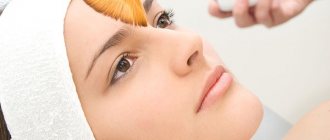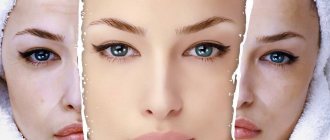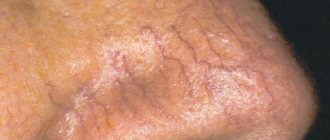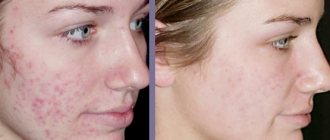Phytin peeling - what is it?
Phytin peeling is a procedure that is used to eliminate fine wrinkles, age spots, superficial scars and stretch marks. The main active component of a special cosmetic composition is phytic acid. Its molecules are large, therefore they do not penetrate into the deep layers of the dermis, but exert their influence exclusively on the superficial epidermis.
Phytic acid reduces melanin synthesis, depigmentes and brightens the skin, normalizes the functioning of the sebaceous glands, stimulates the synthesis of collagen fibers, tightens pores, and gently cleanses impurities. Rice and wheat cake is especially rich in its content.
Special compositions for phytic peeling are combined with tartaric acid, and in some cases glycolic or succinic acid. They are selected taking into account individual sensitivity and the expected effect. Tartaric acid is good for treating age spots, while glycolic and succinic acids have excellent moisturizing properties.
What procedures can be combined with?
Microdermasia (chemical peeling). In combination with peeling it gives a more pronounced rejuvenating result.
Fractional photothermolysis (fractional evaporation of water from the upper layer of the epidermis in order to activate skin regeneration processes). Phytin peeling is used as a preparation for the procedure.
Laser biorevitalization. The active components of the peeling composition destroy intermolecular bonds between epidermal cells, thereby facilitating the penetration of hyaluronic acid deep into the skin.
Who is Hollywood phytin peeling suitable for?
Despite the fact that this chemical peeling came from the USA, it has proven itself well in our climate. It can be done regardless of the season, both winter and summer.
Indications for use
- Photoaging. Acting primarily on the superficial layers of the dermis, this type of peeling gently exfoliates the skin of exposed parts of the body that is dry due to ultraviolet rays (suitable for the face and hands).
- Hyperpigmentation. Reducing the synthesis of melanin and active interaction with its granules located in epithelial cells allows you to quickly lighten the skin and reduce the size and shape of age spots.
- Problems of mature skin and rosacea. This peeling has a pronounced anti-aging effect; suitable for problem skin; fights early wrinkles; It eliminates spider veins and spider veins well, which makes it indispensable for rosacea.
- Striae. Phytic acid stimulates connective tissue cells - fibroblasts, which in turn activate the synthesis of elastin and collagen. Increasing the elasticity of the skin allows you to smooth out superficial wrinkles and also remove stretch marks.
- Superficial skin scars. Phytic acid penetrates only into the stratum corneum of the skin, so even at the highest concentration of 50% and the longest exposure of 15 minutes, the deep layers of the dermis will not be exposed to its action. Superficial scars will thin out and practically disappear, but deep ones, unfortunately, will remain.
Phytin peeling and contraindications
Despite the safety of using phytic acid, phytic peeling does not have clinically proven protocols for the safety of this procedure. It is not yet certified or permitted in the Eurozone countries.
Contraindicated in the following cases:
- Allergy to phytic acid or components of the composition. In this case, you should choose a different type of peeling. Persons with hypersensitivity should also take similar advice.
- Pregnancy and breastfeeding. The active components, penetrating the mother’s bloodstream, enter all organs and tissues with the bloodstream. Their effect on the development and growth of a child has not been clinically proven, but it has not been refuted either, so you should refrain from procedures for this period.
- Molluscum contagiosum. Before starting a peeling course, you should be treated by a dermatologist, otherwise contamination of uninfected skin may occur.
- Herpes virus infection. It is necessary to wait for complete recovery and stable remission in order to begin the procedure.
- Minor wounds, abrasions. Peeling can support the inflammatory process with further formation of deep skin scars.
- Oncological diseases. Any oncological process, regardless of type, type and stage, is a strict contraindication. Peeling can serve as a trigger for their growth or malignant degeneration.
- Eczema and psoriasis. The effect of phytic acid on affected areas of the body can lead to complications of the underlying disease.
- Diabetes. Increased fragility of blood vessels and the formation of hematomas make it impossible to carry out this procedure, since the risk of adverse reactions is higher than the expected effect.
- Cardiac, pulmonary, renal failure. Even a slight external influence (not to mention the peeling itself) can significantly worsen the condition and cause death.
- Manifestations of hypersensitivity to the components of the peeling composition.
Persons with hypersensitivity to the components of the drug may experience the following reactions:
- Active peeling that goes away within 3 days.
- Redness (erythema) in the area of application of the composition for 4 hours.
- Severe non-inflammatory swelling of the face, which decreases after 4-5 hours.
- Exacerbation of herpes virus infection, manifested in the form of skin rashes.
Contraindications for peeling with phytin
Like any procedure associated with an intense, rather than decorative, effect on the skin, “Hollywood peeling” has a number of contraindications. The most common of them include:
- diabetes;
- pregnancy and breastfeeding;
- open wounds, ulcers and cuts on the skin;
- skin hypersensitivity and its tendency to allergies;
- psoriasis;
- eczema;
- skin infections, especially during exacerbation;
- papillomas and herpes lesions;
- oncological diseases;
- renal, pulmonary, liver and heart failure.
Peeling based on phytic acid is a universal and multifaceted procedure that allows you to solve several facial skin problems in one session. With its help, a woman can restore freshness, prolong youth and attractiveness not only at any time of the year, but also without the help of a cosmetologist. All the benefits of such exfoliation will be revealed only if you try it on yourself at least once.
How is phytin peeling done?
The protocol for the phytin peeling procedure differs little from other types and consists of the following steps:
- Removing dirt and makeup.
- Application of a peeling composition containing phytic acid.
- The use of soothing masks and tonics.
- Using special restorative creams with retinol, tocopherol, hyaluronic acid.
It should be noted that cosmetologists recommend pre-peeling preparation with gels with glycolic or compositions with 15% mandelic acid. Apply to cleansed skin once a day for 7 days.
Peeling brands and approximate prices
The cost of one peeling procedure varies from 40 to 60 dollars, the estimated cost of one course is 200-400 dollars. To carry it out, the following brands of cosmetics are used:
- MedicControlPeel (Russia);
- Skin Tech (Spain);
- Beauty SPA (Italy);
- Skin Medica (USA);
- Phytin peeling Renew (Israel).
The cost of pre-peel preparation is $30-40.
Peeling with phytic acid helps to quickly and painlessly cleanse the skin of impurities, smooth out facial wrinkles and remove age spots, and high-quality preparation for its implementation and highly qualified specialists guarantee a pronounced and long-lasting result.
How to carry out phytin peeling at home?
Professional peeling can only be performed in a salon by a qualified specialist. However, the high price of each procedure prompts the search for an alternative, cheaper option.
A recipe for phytic peeling carried out at home should begin with the words: “you need to purchase a product containing phytic acid as a monocomponent or as a combination, such as an almond-phytin composition...”.
In order for the desired effect to be achieved, pre-peel preparation is carried out with compounds containing mandelic or glycolic acid for a week. Before directly applying the peeling composition, use a special lotion with alpha and beta hydroacid. Then carefully apply the main product with phytic acid in one layer to the skin, with the exception of the area around the eyes.
After 10 minutes, everything is washed off with regular warm water, since phytin peeling does not require special neutralization. After the procedure, apply a restorative cream with retinol, panthenol or hyaluronic acid.
Skin care after peeling
The main advantage of phytin peeling is the minimal period of skin regeneration.
By adhering to certain recommendations of cosmetologists, you can restore the skin in the shortest possible time and avoid complications.
Skin care after phytin peeling involves the mandatory application of sunscreen, anti-inflammatory and moisturizers during the first thirty days.
Features of post-peeling care:
- in the first days after the rejuvenation procedure, it is allowed to use only products with a liquid consistency;
- on the third day, when the skin begins to peel, you can apply a moisturizing lotion. It will reduce the feeling of tightness and dryness. Experts recommend using products with hyaluronic acid;
- Cosmetics with Shea butter, ceramides, and phospholipids will help restore the destroyed protective layer;
- Preparations with Panthenol are effective in use. They have a good regenerating and restorative effect on skin cells;
- In order to eliminate swelling and inflammation after phytin peeling, it is good to apply cosmetics to the skin that contain selenium or tocopherol.
How many phytin peeling procedures should be done to see results?
The first results will be noticeable after the first procedure: the skin will acquire a healthy color, firmness and elasticity, and the number of age spots and spider veins will significantly decrease. However, in order to consolidate the effect, you will have to meet with a cosmetologist 4 to 8 times during 1 course of therapy. Procedures are carried out once a week, their number is determined by a specialist.
Negative consequences
There are almost never any negative consequences observed. In rare cases, redness of the skin may occur. However, it goes away within an hour. If swelling occurs, you should consult a doctor. This is an allergic reaction. You will need to take a course of special medications.
If a visitor to a beauty salon is prone to the appearance of herpes on the lips or facial skin, this ailment may worsen after the procedure. Treatment in this case should also be prescribed by a doctor. You may need to take a course aimed at increasing immunity.
According to reviews from visitors to beauty salons, negative consequences after peeling occur extremely rarely.
Which peel to choose: phytin or glycolic?
Phytin peeling is gentle and acts exclusively on the cells of the stratum corneum of the skin, gently and efficiently exfoliating them. It has virtually no side effects and is an effective procedure, especially for rosacea. Its use is justified in people with oily and problem skin. The disadvantage of phytin peeling is its price and insufficient clinical research base for its safety.
Glycolic peeling not only cleanses the skin, but also actively moisturizes it. It is actively used in people with dry and sensitive skin. Compared to phytin, it is cheaper and can be easily used at home. If you still have doubts about choosing the type of peeling, you should consult with a cosmetologist who will help you choose a course of procedures according to the individual characteristics of your skin.
Description of the procedure
Phytin facial peeling is a common procedure. It is often carried out in beauty salons. It should be noted that the creation of a product that is used in the treatment of leather is carried out using innovative formulas. To obtain high efficiency, you need to give preference to salon procedures.
During the treatment, products that contain phytic acid are used. It is obtained during the processing of plant raw materials. Most often, rice or wheat is used for these purposes. The main purpose of this type of peeling is to combat acne. The procedure also allows you to reduce the intensity or completely remove age spots.
Phytic acid also helps brighten and rejuvenate the skin. It becomes more elastic. Small wrinkles are smoothed out. In this case, the treatment does not cause discomfort or burning. It is prescribed by cosmetologists even for girls with very sensitive skin.
Real reviews about phytin peeling
Phytin peeling is the most gentle of all such procedures, really! It doesn’t pinch or bake anything, either during or after it. Usually, after peeling the face with another acid, I had to pee at work at my own expense, since my face was red. But the most important thing is that it is effective!
I will attach my photos before and after the procedure:
I only went to see it once, and already the acne marks are almost invisible. In addition, the wrinkles have smoothed out a little. The master said that fitting peeling needs to be done 4 - 6 times once a month for the result to be 100%.
Purpose of the procedure
According to reviews, phytin peeling is an effective procedure for a number of defects and pathologies of the skin. It is important to treat your face regularly. This allows you to get the desired result after just a few sessions.
The presented procedure is an effective remedy against excessive production of subcutaneous fat. It is also a good option for treating skin with acne or increased pigmentation.
If the skin has become hard and rough, peeling with phytic acid can restore its tenderness and softness. In this case, you don’t have to worry about irritation. Masks, when using a special set of components, remove the upper dead particles. The presented product can remove small scars on the face, smooth out wrinkles, and remove traces of rosacea. It is also a powerful preventative against age-related skin changes.











